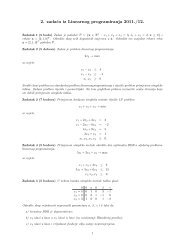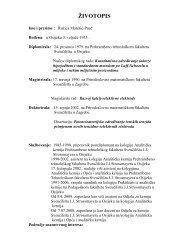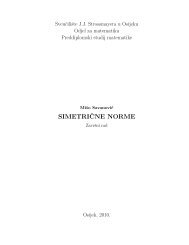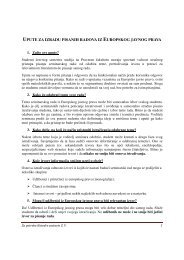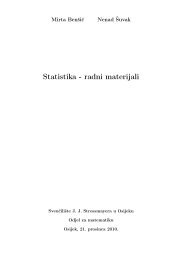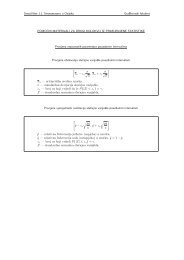Theta lifts of strongly positive discrete series: the case of (˜ Sp(n),O(V ))
Theta lifts of strongly positive discrete series: the case of (˜ Sp(n),O(V ))
Theta lifts of strongly positive discrete series: the case of (˜ Sp(n),O(V ))
Create successful ePaper yourself
Turn your PDF publications into a flip-book with our unique Google optimized e-Paper software.
Observe that Proposition 5.2 implies that <strong>the</strong> representation σ(l) is nota <strong>discrete</strong> <strong>series</strong> representation for l > r.There are two main <strong>case</strong>s which we consider.Suppose that <strong>the</strong> representation χ V,ψ ν 1 2 does not appear in [σ]. Sincem r − n = 1, Theorem 4.3 yields 2 n′ ≥ r ′ + 1(dim(V ɛ2 0 ) − 1). We have twopossibilities:• n ′ = r ′ + 1 2 (dim(V ɛ0 ) − 1)In this <strong>case</strong> both representation χ V,ψ ν s ⋊σ cusp and ν s ⋊τ cusp reduce for s =1. Therefore, by Theorem 3.1, <strong>the</strong>re is no representations <strong>of</strong> <strong>the</strong> form χ 2 ,ψν sappearing in [σ]. Fur<strong>the</strong>r, Theorem 3.5 <strong>of</strong> [6] implies that <strong>the</strong> representationχ V,ψ ν s ρ i ⋊ σ cusp reduces if and only if <strong>the</strong> representation ν s ρ i ⋊ τ cusp reduces.One <strong>of</strong> <strong>the</strong> main results <strong>of</strong> <strong>the</strong> paper [4] states that σ(r) is a <strong>discrete</strong> <strong>series</strong>representation. Applying Theorem 2 we obtain <strong>the</strong> embeddingσ(r) ↩→ δ([ν a 1ρ ′ 1, ν b 1ρ ′ 1]) × δ([ν a 2ρ ′ 2, ν b 2ρ ′ 2]) × · · · × δ([ν a lρ ′ l, ν b lρ ′ l]) ⋊ τ sp ,where a i ≤ 0 and ρ ′ i ∈ {ρ 1 , ρ 2 , . . . , ρ k } for i = 1, 2, . . . , l, and τ sp ∈ Irr(O(V ɛr ′))a <strong>strongly</strong> <strong>positive</strong> <strong>discrete</strong> <strong>series</strong>, for some r ′ .Since <strong>the</strong> representation σ is <strong>strongly</strong> <strong>positive</strong>, Theorem 4.3 and Lemma3.3 show that for every i ∈ {1, 2, . . . , k} <strong>the</strong>re is at most one representation<strong>of</strong> <strong>the</strong> form ν x ρ i that appears in [σ(r)] with 0 ≤ |x| < 1. In <strong>the</strong> same way asin <strong>the</strong> pro<strong>of</strong> <strong>of</strong> Proposition 5.3 we deduce σ(r) ≃ τ sp , i.e., σ(r) is a <strong>strongly</strong><strong>positive</strong> representation.It is now easy to see, using Lemma 3.2, that σ(r) is unique irreduciblesubrepresentation <strong>of</strong> <strong>the</strong> induced representation(k∏ ∏k iδ([ν aρ i −ki+j ρ i , ν b(i) jρ i ])) ⋊ τ cusp .i=1 j=1Suppose that Θ(σ, r−1) ≠ 0. Then Proposition 5.2 implies R P1 (Θ(σ, r))(ν 1 2 ) ≠0, which is impossible. Thus, r is <strong>the</strong> first occurrence index <strong>of</strong> σ.• n ′ > r ′ + 1 2 (dim(V ɛ0 ) − 1)20



